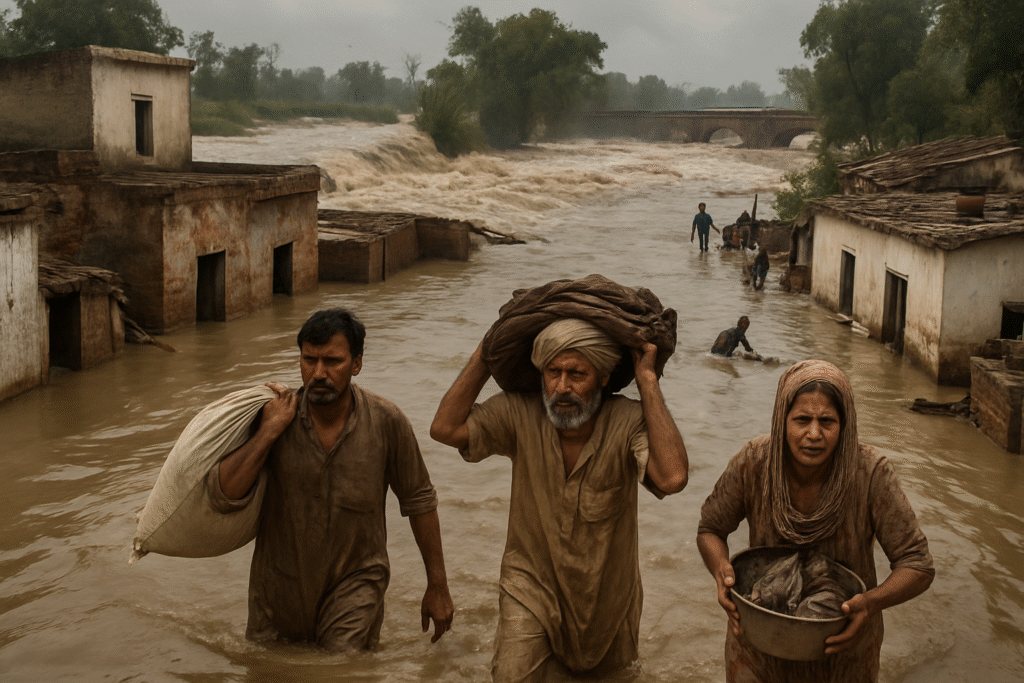Punjab floods 2025 have struck hard, echoing the devastation of 1988. Heavy rains and river overflows ravage villages. Experts blame human actions for worsening these natural calamities.

Echoes of 1988: History Repeats in Punjab Floods 2025
Punjab faces its worst floods since 1988. Rivers swell beyond control. Thousands lose homes and crops. However, man-made factors intensify the crisis. Climate change fuels heavier monsoons. Yet, human greed plays a bigger role.
In 1988, floods killed over 500 people. Flash floods destroyed crops. Punjab lost 75% of its summer harvest. Now, Punjab floods 2025 mirror that horror. Over 1,000 villages submerge. More than two million suffer.
Experts compare the two events. Back then, excessive rain triggered chaos. Today, similar patterns emerge. But additional issues arise. Deforestation and urban sprawl add fuel. Transitioning to current causes, let’s examine key culprits.
Climate Change: The Unseen Force Behind Punjab Floods 2025
Climate change worsens monsoon rains. Punjab receives 26.5% more rain this year. Global warming intensifies downpours. Flash floods and landslides follow. Moreover, cross-border water releases from India heighten risks.
A senior official notes, “This is the biggest flood in Punjab’s history.” Maryam Aurangzeb highlights affected millions. Rivers like Sutlej, Chenab, and Ravi reach record levels. Therefore, evacuations ramp up urgently.
Studies confirm climate’s role. Warmer air holds more moisture. Rains become extreme. In Punjab floods 2025, this pattern dominates. However, natural factors alone don’t explain everything. Human interference magnifies the damage.
Choked Drains and Encroached Floodplains: A Recipe for Disaster
Choked drains block water flow. Waste clogs systems. Floodwaters rise quickly. Encroached floodplains worsen the issue. People build on riverbanks illegally. Natural buffers vanish.
In Punjab floods 2025, breaches in embankments cause havoc. Just like in 1988, poor management fails. Farmers lose acres. Muhammad Amjad shares, “Thirteen of my 15 acres vanished.” His rice crops drown completely.
Moreover, urbanisation seals soil with concrete. Water can’t seep in. Runoff increases dramatically. Studies show this concretisation boosts flood severity. Transition words like “therefore” link these ideas clearly. Consequently, low-lying areas flood faster.
Experts point to multiple studies. One reveals that illegal constructions choke drains. Floodplains shrink due to encroachments. As a result, water has nowhere to go. Punjab floods 2025 expose these flaws vividly.
Deforestation: Stripping Away Nature’s Defenses
Deforestation removes vital tree cover. Trees absorb rainwater. Without them, soil erodes quickly. Flood risks soar. In Punjab, logging and farming clear forests. This pattern repeats globally.
Research from 56 countries links deforestation to floods. Every 10% tree loss hikes flood risk by 28%. Bradshaw’s study warns of this danger. In Punjab floods 2025, deforested areas suffer most.
Furthermore, roots stabilize land. Their absence triggers landslides. Water flows unchecked into rivers. Consequently, overflows devastate villages. A farmer laments, “My house is gone. We live on roadsides now.”
Transitioning to broader impacts, deforestation alters water cycles. Less absorption means more runoff. Studies in Brazil show reforestation reduces peaks. Punjab needs similar action. However, current trends ignore this.
Concretisation: Turning Land into Flood Magnets
Concretisation covers earth with buildings. Soil loses absorption power. Rainwater rushes into drains. Overloaded systems fail. Urban areas in Punjab flood easily.
In cities like Zirakpur, waterlogging persists. Bridges submerge. Roads become rivers. This mirrors global urban flood trends. Moreover, groundwater depletion adds woes. Paddy farming drains aquifers.
A YouTube analysis explains, “Urbanisation blocks water absorption.” Ground can’t soak rain. Floods intensify. Therefore, Punjab floods 2025 hit urban zones hard. Transition to solutions seems urgent now.
Studies highlight concretisation’s role. It increases flood frequency. In Myanmar, similar patterns predict worse damage. Punjab follows suit. As a result, experts urge green infrastructure.
Human Activities Over Years: A Pattern of Neglect
Over years, human actions build up risks. From 1988 to now, patterns persist. Deforestation continues unchecked. Encroachments grow. Climate change accelerates everything.
In 1993, embankment breaches caused floods. Similar issues recur in Punjab floods 2025. Studies point to man-made factors repeatedly. However, governments respond slowly.
A resident recalls, “I was young in 1988. This feels worse.” Manpreet Singh notes submerged villages. Transition words emphasize continuity. Consequently, history teaches harsh lessons.
Multiple studies confirm human impacts. Bradshaw et al. link forest loss to deaths. Another shows urban growth expands flooded areas. In Punjab, these factors combine lethally.
Impacts on Lives and Livelihoods in Punjab Floods 2025
Floods displace nearly 500,000 people. Deaths reach 33 in days. Livestock perishes. Farms submerge under water.
Over 61,000 hectares of farmland drown. Crops like rice and potatoes rot. Amish Sultan says, “My buffaloes are frail. Income vanished.”
Moreover, villages turn into lakes. Evacuations use boats. Tent camps house refugees. Transition to economic toll reveals billions in losses.
Infrastructure crumbles. Roads and bridges fail. Schools close. Health risks rise with contaminated water. Therefore, recovery will take months.
Lessons from Studies: Preventing Future Calamities
Studies urge action. Reforestation can mitigate floods. One Brazilian study shows reduced peaks with trees.
Furthermore, clear drains regularly. Enforce floodplain protections. Ban encroachments strictly.
Climate adaptation matters too. Build resilient infrastructure. However, implementation lags in Punjab.
Experts quote, “Deforestation leads to intense floods.” Global Change Biology highlights this. Transition to policy changes seems essential.
Punjab floods 2025 demand reforms. Integrate green practices. Restore forests aggressively.
Path Forward: Building Resilience Against Punjab Floods 2025
Resilience starts with awareness. Educate communities on risks. Promote sustainable farming.
Moreover, invest in early warnings. Strengthen embankments. Monitor dams closely.
International cooperation helps. India and Pakistan share flood data. Consequently, cross-border issues reduce.
Quotes from officials stress urgency. “Two million affected,” Aurangzeb warns. Transition words guide this narrative smoothly.
Finally, Punjab floods 2025 serve as a wake-up call. Human actions must change. Nature demands respect.





